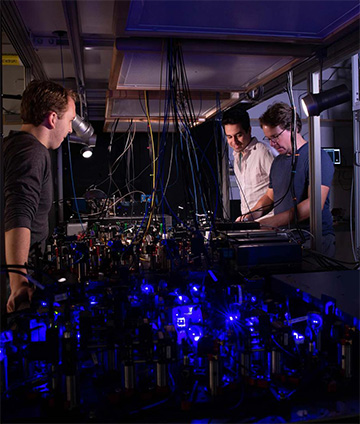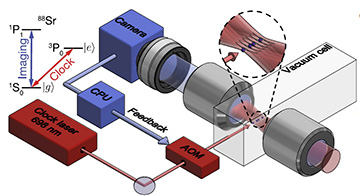
Adam Shaw, Ivaylo Madjarov and Manuel Endres work on their laser-based apparatus at Caltech. [Image: Caltech]
Apropos of a New Year, Father Time might now carry a third, more accurate type of optical clock—though research, rather than strictly timekeeping, may be its ultimate purpose. Scientists at the California Institute of Technology (Caltech) and NASA’s Jet Propulsion Laboratory, USA, have reported a prototype atomic-array optical clock that uses optical-tweezer technology to combine the benefits of single-atom and optical-lattice clocks (Phys. Rev. X doi: 10.1103/PhysRevX.9.041052).
Bridging control and precision
At present, the most accurate and stable optical clocks use optical interrogation of either a single ion or an ensemble of neutral atoms confined in an optical lattice (see “Toward the Optical Second,” OPN, February 2019). They have enabled new experiments in geodesy, fundamental physics and quantum many-body physics.
The Caltech prototype optical clock platform is based on an array of about 40 strontium atoms, each one trapped by an optical tweezer. The researchers load the array from a cold atomic cloud and then induce light-assisted collisions to eliminate higher trap occupancies.
Then, the team uses a laser to excite the individual atoms and a camera to make readings of their fluorescence. To generate an error signal, the researchers interrogate once below resonance and once above. This atom-by-atom feedback control, they say, enables direct estimation of laser noise contribution.
In the clock setup, around 40 88Sr atoms, trapped in an array of 81 optical tweezers, are interrogated by a 698-nm clock laser, with fluorescence imaging used to detect population changes in the clock states with single-atom resolution, and with feedback control through an acoustic-optic modulator (AOM) used to minimize laser noise. [Image: I.S. Madjarov et al., Phys. Rev. X, doi: 10.1103/PhysRevX.9.041052 (2019); CC-BY 4.0] [Enlarge image]
“The oscillations of our laser light act as a pendulum that counts the passage of time,” Ivaylo Madjarov, a Caltech physics graduate student and the study’s lead author, said in a press release accompanying the paper. “The atoms are a very reliable reference that makes sure that pendulum swings at a constant rate.”
Reducing noise
The 40 strontium atoms the Caltech researchers use constitute a high enough number “to reduce quantum noise by about a factor of 6 compared with the single-atom case,” writes Andrew Ludlow, U.S. National Institute of Standards and Technology (NIST), in a commentary on the paper. Ludlow adds that the several-micron spacing of the atoms helps to tamp down “disruptive atomic interactions.”
Ludlow notes that other research groups are also exploring so-called tweezer clocks. Indeed, paper by a NIST team led by Adam Kaufman, which demonstrated a tweezer clock using a smaller array of five strontium atoms, was published in the past October.
The authors of that study, Ludlow noted, “employed an advanced cavity-stabilized clock laser” that enabled “coherence-preserving atomic interrogations of up to four seconds—an impressive number not only for a tweezer clock but for any optical clock.” Those conditions, according to Ludlow, allowed the team to log greater frequency stability than the Caltech–JPL group.
Entangled states
The authors of the new study write that their clock demonstration and that of the NIST group “provide the foundation for establishing a third optical clock platform promising competitive stability, accuracy, and robustness, while incorporating single-atom detection and control techniques in a natural fashion.”
That combination could find use in emerging quantum studies, according to Caltech’s Manuel Endres, the team leader for the new study. In a press release, Endres noted that the atoms in these systems can become entangled and that this entangled state can further stabilize the clock. Thus, he says, “Our approach can also build a bridge to quantum computation and communication architectures.”

